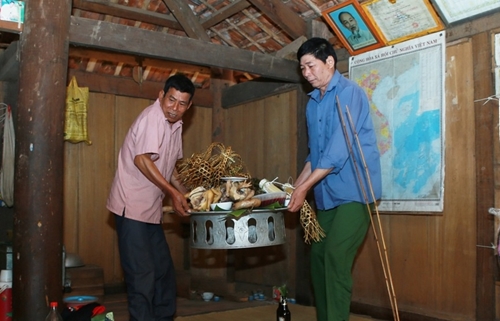Meanwhile, girls have to learn how to embroider ‘khan pieu’ (traditional scarf of Black Thai women), weave cloth, and do the farming. Additionally, they also have to train their ears to be able to hear the sound of the ‘khen’ and distinguish between the sounds of friends calling to hang out and of boys expressing their love.
The boy and the girl are allowed to make friends. Then, the boy will ask his mother and some relatives to come to the girl’s house. They will follow the custom called ‘long luong’ to ask for permission for the two of them to go on a date.
    |
 |
|
Offerings from the groom’s family to the ancestors of the bride’s family in the wedding of the Black Thai people |
After getting to know each other for a while, the boy’s family, led by a local matchmaker, brought offerings including chicken, pork, alcohol, and rice to the girl’s house to express the wish for the couple to live together. The girl’s family and relatives may accept an offer for the couple to have an official relationship, but have not yet accepted the proposal.
A few months later, the boy’s family performs another ritual to consult the girl’s family called ‘to pac.’ The boy’s family will bring offerings to the girl’s house and prepare a banquet to invite the two families. The girl’s family openly asked the couple about their desire to get married. If they agree, the girl’s family will let them be married and the groom will live with his wife’s family.
According to the matrilocal residence custom of the Black Thai people, the groom lives and work in the bride’s house with her family members, but sleeps in a separate space. The period of living with the bride’s family depends on each clan and the agreement reached by both sides. Ha Van Dung from Huoi Toi village in Son La said, “When living with the bride’s family, the man must follow their traditions. In fact, this is the opportunity for him to learn how to be a breadwinner, gain experience in farming, build a house and weave bamboo and rattan.”
After a while, the groom’s family holds a wedding ceremony and bring offerings to the bride’s ancestors. The offerings include steamed pork and chicken, grilled fish, pickled fish, chicken eggs, seeds, betel, areca, and a jar of ‘Can’ wine (a fermented rice wine drunk from tubes). The groom’s family prepares a feast for the bride’s relatives and provides food for the wedding at her house.
“In the wedding, women in the bride’s family hold ‘tang cau’ ceremony (a ritual of tying hair into a bun on top of her head to signify a married woman) for her. The bride wears ‘ao com’ (a traditional costume of Thai women), silver brooch and ‘khan pieu.’ The women talk to her about living with the husband’s family,” said Lo Thi La from Huoi Toi village.
According to Dao Quang To, a member of the Son La provincial Association of Literature and Arts, who has spent years studying the customs and rituals of the Black Thai people, “the Black Thai people in Son La province have built and formed their own marriage traditions. Long-established wedding customs, with unique rituals and cultural features, are highly respected by the Black Thai people. Today, besides observing the Law on Marriage and Family, they still maintain those good customs.”
Translated by Trang Linh - Ma Thi Dung